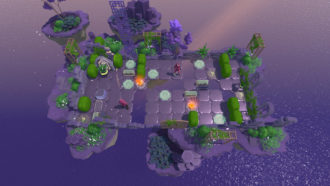After Light Fades is a Sokoban puzzler that has just been released by Adelaide developers Lamplight Forest. You play as Alice, a sleek, hooded figure who is mourning the loss of her partner, Aura. The game opens with a short narrative that discusses their love for each other and provides a plot and the reason why you are suddenly solving puzzles and progressing through different landscapes. Aura, unfortunately, was burnt to death, but in her ashes, she left seven artefacts that Alice quickly snatched up. These artefacts reminded Alice of seven different important places that meant something to her and Aura. To get over her grief, Alice must complete all the puzzles at each of these seven locations to “finally start again.”
There are two game modes in After Light Fades – a level creator, which opens up into a display of add-ons and different maps, and the standard game mode. In the latter, you will find yourself playing through seven different levels, each with dozens of different puzzles to complete. The main mechanic of the Sokoban genre, for those who aren’t aware, is pushing items away to find a way to exit the puzzle, similar to indie darling Baba Is You. The game’s art style and vibe are very different to Baba, however, leaning more into the mystical with Alice being depicted as a faceless, cloaked figure.
The items in After Light Fades connect with the game’s spiritual vibe and consist of crystal skulls, fire and vines, all of which will get in the way of progressing. The game doesn’t hold your hand whatsoever throughout your playthrough, providing zero clues to help you, so really, this is for hardcore puzzle fans and those who love and are familiar with Sokoban. The first level Alice will find herself in is the graveyard, where your starting point is a coffin, symbolising your grief and how you are moving towards some kind of peace. Flowers indicate each new stage within the level, with each level containing around four different puzzles.

Each new puzzle is a new garden, with an isometric top-down view. Your main goal per puzzle is to move a tile that depicts a key to an unmovable padlock tile. When these two tiles interact, a gate will open, leading you to traverse through a now-unlocked gate that will lead you onto the next puzzle.
The items that you will have to move around to make sure you can connect the key and padlock are varied, and each has its own move set. For example, the ”earth” tile, which is a potted plant, can be pushed into a hole of its exact size. However, these plants can only be moved by pushing forward, then back on your controller’s joystick, and this can only be done if Alice has a substantial amount of room around her. You can’t move an item if your back is up against a wall or an item, meaning that every move you make is imperative. The game does provide a ”rewind” button that comes in handy if you need to delete your last few moves. It also provides a complete reset button in case things have gone too far and you need to completely start over.
The level creator mode gives players a blank environment to make their own After Light Fade style puzzles. I found this pretty easy to work through, and loved to see all the different items that could be used, some of which I hadn’t encountered yet in my main playthrough. This creator is supported by Steam Workshop, which makes it easy to edit your puzzles and also gives you the opportunity to try other creations made by players.
Overall, I found After Light Fades to be extremely difficult due to my lack of knowledge of the Sokaban puzzle mechanics. When I did get stuck, there were no hints to help me, leaving me frustrated that I couldn’t continue exploring such a gorgeous world with a narrative that I was genuinely intrigued to follow. For that reason, After Light Fades is for gamers who either love Sokoban puzzles or who wish to really flex their puzzle-solving abilities.
After Light Fights is now available on PC, and it also has a demo on Steam if you want to try before you buy.











